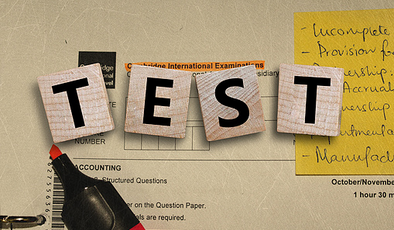如何准备ACA专业阶段考试?
 还在为专业阶段课程的学习而发愁么?ICAEW的考官们提出了他们的见解,以反映ACA学员在掌握知识过程中的进展。 财务会计方面 在ACA专业阶段课程中,Financial Accounting and Reporting的课程考核是建立在学员在证书阶段的会计考试中所学知识的基础之上的。 专业阶段的学习材料将介绍新的财务报告准则和集团财务报表,并要求学员在处理交易时熟悉国际财务报告准则(IFRS)和英国一般公认会计准则(UK GAAP)之间的差异。为了加强对财务报表整合的考察,考卷由四道大题组成。第一个问题通常包含对余额列表和一些交易的考察。该题目倾向于要求学员准备单个公司的财务报表,同时还可能要准备财务报表单个附注(individual notes)。 其次,对复式记账法的理解至关重要。通常需要学员基于对财务报告准则的运用来调整交易,这构成了考试的核心。 在证书阶段的Accounting考试中考过的现金流量表也是专业阶段财务会计与报告考试中的一部分。题目可能从集团公司的角度考察,也可能是抽离出单个公司进行考察。 这部分新领域要求对财务报告准则知识点的掌握和应用。学员将被要求阐明如何对交易进行适当会计处理,可能涉及重新计算关键指标,例如利润或债务;或者编制调整财务报表所需的日记账(journals)。集团财务报表在专业阶段也是新内容,这将涉及合并财务报表的编制和对复式记账法的应用,但通常是隐含在题干中,不会明示给学员。 审计方面 在ACA专业阶段课程中,Audit and Assurance的课程主要建立在证书阶段Assurance课程的基础上。学员必须在相关概念、道德、风险评估、内控和审计程序方面有扎实的基础。 考卷包含四道大题。第一个问题由六个简短的小问题组成,要求以报表附注的格式作答。第二个问题基于一个大情境,通常约40分,它要求学员证明为何特定的审计风险领域已经被识别,并设计适当的审计程序来应对这些风险。学员将被要求运用财务信息来作答。剩下的两个问题涵盖了任何一个可考查的考点,并由多个部分组成。 在证书阶段Assurance的课程中,学员需要从给定的选项中选择最合适的内部控制或审计程序,而在专业阶段,学员必须为既定场景设计自己的内部控制和审计或审查程序。 Audit and Assurance课程引入了一些新的国际审计准则(ISAs),这个知识点将在试卷任何一个地方考到,主要考点是改进鉴证报告。虽然Assurance课程中涵盖了鉴证报告的基本原则,但学员必须识别并阐释特定情况下需要的鉴证报告类型。 商业分析方面 在证书阶段中,Management Information和Business,Technology and Finance考题类型为单选题;而在专业阶段,Financial Management以及Business Strategy and Technology的考试则要求学员处理更长的数字题和文字题。学员可以自己选择答案以及计算过程的排版格式,这些技巧可以通过借助考试软件中的练习加以培养。 在证书阶段中,考题一般是针对单一知识点在小场景中的有限应用。但专业阶段课程Financial Management和Business Strategy and Technology的学习都建立在这样的认知基础上——知识是一直在发展的、集成的、扩展的和增强的。例如,在Business Strategy and Technology课程中,学员需要结合来自业务、技术和财务的概念和模型,使用在Management Information中学到的数据分析,以评估性能、识别问题等。在Financial Management的学习中,学员可以对在Management Information中学到的投资评估知识进行扩展,以便进行更复杂的净现值计算。 在专业阶段中,对知识的评估也非常不同。Financial Management和Business Strategy and Technology考试都包含三个问题,涵盖多个教学大纲领域。考卷将测试学员在更复杂的实际场景中应用技术知识的能力。学员被要求为特定的问题制定合理的解决方案,运用自己的判断(道德上的)并提出建议。 税务方面 在证书级别课程中,Principles of Taxation课程主要阐述税务知识,其目标是使学员能够识别哪一种税适用于哪一项交易,因此考题会单独测试每一项税务知识,而且非常简单。 Tax Compliance是专业阶段的一门科目,考题变得更长更复杂。考题仍然分别测试每一种税务知识。其目的是测试学员为历史交易准备税务计算的能力。新的税收知识,如印花税和遗产税也被引入课程中。然而,它仍然是一个以书面知识为基础的考试。 Business Planning:Taxation是关于税务的最后一门考试。考题常常通过时间变化、税收种类变化来测试学员在特定场景(如税务规划)给客户提出相应建议的能力。考试侧重点从纯粹的书面知识转移到实际应用技能的能力。学员不需要详述基础知识,但是需要证明自己可以将技术知识应用于多种税务场景。 类似于Business Planning:Taxation、Business Strategy and Technology科目,学员应该将重点放在实际应用技能上,而不是基础知识上。Business Planning考试中仅有25%的部分考察基础知识,其余部分都将集中考察实际运用的能力。 在这些考试中对实际应用技能的强调表明了学员在学习下一个阶段时应该注意的地方,并让学员了解ACA高级阶段课程中自己需要达到什么样的水平。 Preparing for the Professional level Stepping up to the Professional Level of the ACA can feel daunting.Moving from the fundamentals of accountancy finance and business at the Certificate level,the Professional Level will test your ability to use technical knowledge in real-life scenarios. The examiners have presented their insight to mirror the progression within the knowledge streams of the ACA. Financial accounting stream The Professional Level Financial Accounting and Reporting exam is built on your fundamental understanding of topics and concepts initially learned from the Certificate Level Accounting exam. The learning materials will introduce new financial reporting standards and group financial statements,as well as requiring you to be familiar with differences between IFRS and UK GAAP when dealing with transactions.The exam consists of four questions and reinforces an understanding of the integration of financial statements.The first question usually consists of a list of balances along with some transactions.The requirement tends to ask you to prepare single company financial statements and possibly individual notes to the financial statements. An understanding of double entry is critical.The transactions that require adjusting are usually based on an application of financial reporting standards that form the core of this exam. Statements of cash flow,examined in Accounting are also part of Financial Accounting and Reporting.They will either be tested from a group perspective or extracts from a single company. The main new areas are knowledge and application of financial reporting standards.You'll be asked to explain the appropriate accounting treatment of a transaction,which may involve recalculating key metrics such as profit or debt,or showing the journals required to adjust the financial statements.Group financial statements is also new at the Professional Level.This will involve preparation of consolidated financial statements and application of double entry fundamentals,although this will usually be implicit rather than explicit in the question requirements. Audit stream The Professional Level Audit and Assurance exam builds directly on the Certificate Level Assurance exam.All topics and concepts remain relevant.It is imperative that you have a solid grounding in concepts,ethics,risk assessment,internal controls and audit procedures. The exam contains four questions.The first consists of six short-form questions,which we expect to be answered in note form.The second question is based around a large scenario and is usually around 40 marks.It requires you to justify why specified areas of audit risk have been identified and design appropriate audit procedures to address those risks.You will be expected to interpret financial information as part of your justification.The two remaining questions cover any of the examinable topics and could have multiple parts.All topics can be tested via the short-form questions or within a larger question. Whereas in Assurance you were required to select the most appropriate internal control or audit procedure from given options,you now have to generate your own internal controls and audit or review procedures for a given scenario. A number of new International Standards on Auditing(ISAs)are introduced at Audit and Assurance,and could be tested anywhere on the exam.However,the main additional topic is that of modified assurance reports.While the basic principles underlying assurance reports are covered in Assurance,you'll now have to identify and explain the type of assurance report needed for a given situation. Business analysis stream While the Certificate Level Management Information and Business,Technology and Finance exams require you to answer multiple choice questions or complete limited data entry,the Professional Level Financial Management and the Business Strategy and Technology exams require you to undertake much longer numerical and written tasks.It is up to you to choose the appropriate layout and presentation of your answer(and workings);develop these skills by practising with the exam software. At Certificate Level,pure knowledge and the limited application of knowledge in small scenarios is examined.Financial Management and Business Strategy and Technology build on that knowledge-it is developed,integrated,extended and enhanced.For example,in Business Strategy and Technology you are required to perform data analysis using Management Information techniques in conjunction with concepts and models from Business,Technology and Finance in order to assess performance,identify issues etc.In Financial Management you extend your knowledge of investment appraisal from Management Information in order to undertake more sophisticated and complex net present value calculations. Knowledge is also assessed very differently at the Professional Level.The Financial Management and Business Strategy and Technology exams both contain three questions covering multiple syllabus areas.These test your ability to apply technical knowledge in longer and more complex real-life scenarios than at Certificate Level.You are required to develop reasoned solutions to specified problems,exercise your judgement(ethically)and recommend action.Written and communication skills are essential.For example,in Business Strategy and Technology only 25%of the marks are for applying knowledge.The rest are for applying your skills to the given scenarios. Tax stream The Certificate Level Principles of Taxation exam is designed to teach you about the core taxes.The objective is to be able to recognise which tax will apply to a transaction,so questions test the taxes individually and are simplistic.Although there are two long-form questions,they are still only 10 marks each.Most are two mark objective test questions. Tax Compliance is the next exam in this stream.Questions become longer and more complicated.They still test each tax separately,apart from a small amount of interaction between VAT and stamp taxes.The objective is to show your competence in preparing tax computations for historic transaction.New taxes are also introduced:stamp taxes and inheritance tax.However,it remains a knowledge-based exam with a small element of application of skills. Business Planning:Taxation is the final exam in this stream.Questions often change from the past to the future tense and from single taxes to multi-tax scenarios that consider the interaction of taxes.The objective is to consider various different options for a client who needs advice on a particular scenario,such as tax planning.The emphasis shifts from detailed technical knowledge to an ability to demonstrate skills.You do not need detailed technical knowledge,but you do need to demonstrate that you can apply technical rules to a scenario involving multiple taxes. Similarly to Business Planning:Taxation,Business Strategy and Technology,along with the other Business Planning modules(Banking and Insurance),focuses on the skills you apply rather than the technical knowledge you can show,the marks for the Business Planning exams are split 25%knowledge to 75%skills you apply. The emphasis on skills within these exams are indicative of the next stage in your ACA learning,and give you a first glimpse of what you can expect at Advanced Level. 来源:微信号【ICAEW_Students】,由中国ACA考试网【www.aca.cn】整理发布,若需引用或转载,请注明来源! |






